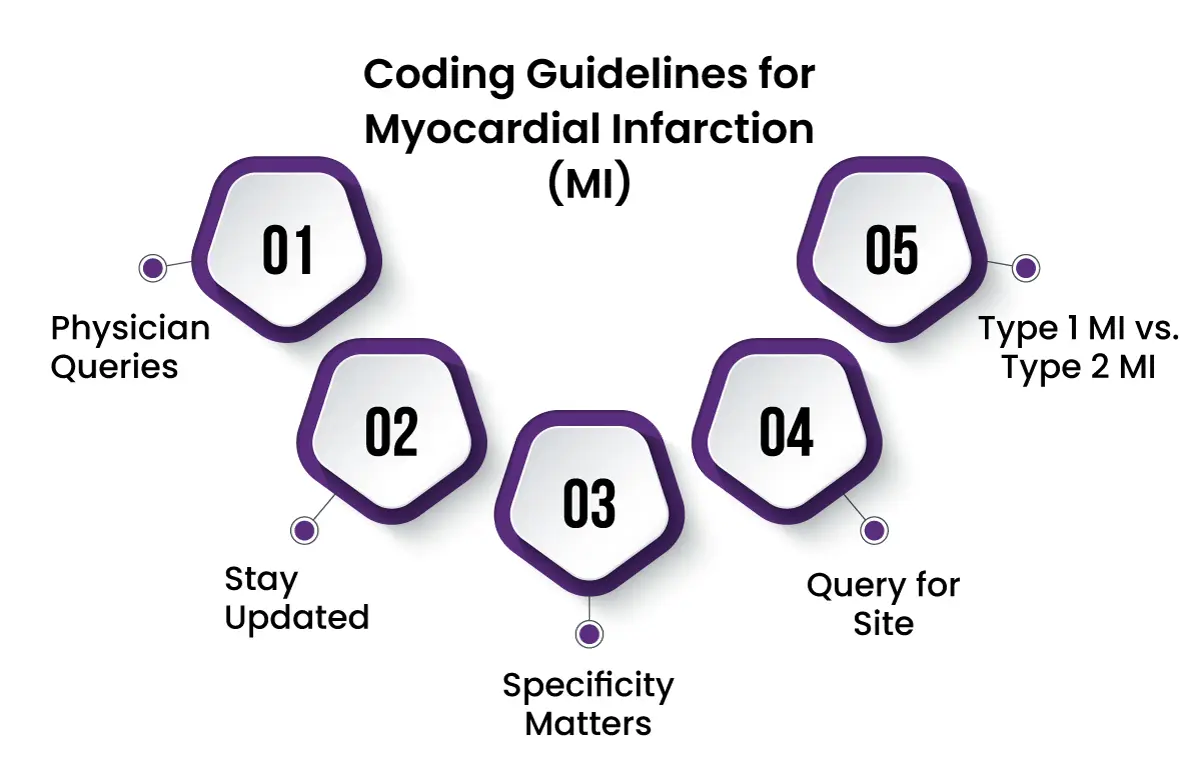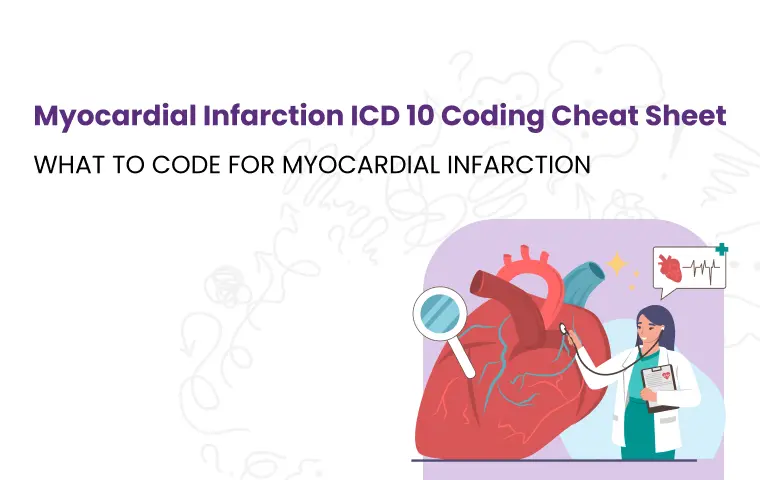Accurately coding for myocardial infarction (MI) can feel like traversing a complex maze. The specific diagnosis codes for MI can vary depending on a multitude of factors – the type of heart attack, its location, and whether it's a new or recurring event.
In this post, we'll discuss the different types of MI and their corresponding ICD-10 codes. We'll also provide a comprehensive guide to help you select the most appropriate codes for each unique case, streamlining your billing process and improving claim accuracy.
What are the Billable Myocardial Infarction ICD-10 Codes?
The ICD-10 codes for myocardial infarction (MI) fall under category I21. They are usually classified according to various factors.
Acute Myocardial Infarction
The ICD-10 code for acute myocardial infarction is I121. Coding for acute myocardial infraction hinges on two main categories:
1- STEMI (ST-Evaluation Myocardial Infarction): This type of heart attack is characterized by an elevated ST segment on an electrocardiogram (ECG). The icd 10 codes for stemi range from I121.0 -I121.3
-
I21.0ST (STEMI) myocardial infarction of anterior wall
-
I21.1ST (STEMI) myocardial infarction of inferior wall
-
I21.2ST (STEMI) myocardial infarction of other sites
-
I21.3ST (STEMI) myocardial infarction of unspecified site
A myocardial infarction (MI) is classified as acute if it occurs within 4 weeks of the initial symptom onset. If more than 4 weeks have passed, it's considered an old MI.
The ICD-10 code for a history of MI, regardless of whether it was initially a STEMI or NSTEMI, is:
I25.2 (Old myocardial infarction)
This code encompasses all types of previous heart attacks that have healed. While some clinicians may inquire about specific details of past MIs, the standard ICD-10 coding doesn't differentiate between STEMI and NSTEMI history when assigning I25.2.
2- NSTEMI (Non-ST-Elevation Myocardial Infarction): In NSTEMI, the ST segment is not elevated, but there are other indicators of heart muscle damage. NSTEMI is coded as I21.4.
Type 2 MI
A mismatch between oxygen supply and demand causes this type of MI. The assigned ICD 10 code for Type 2 MI is I21.A1.
What will you code if a patient's NSTEMI evolves to STEMI?
In the scenario where a patient initially presents with NSTEMI (Non-ST Elevation Myocardial Infarction) but later evolves into STEMI (ST Elevation Myocardial Infarction), the coding becomes tricker.
If the patient initially presents with NSTEMI and it later evolves into STEMI during the same encounter, you would code it as STEMI. This is because the final diagnosis is the determining factor for coding.
In the rare instance where a Type 1 STEMI (spontaneous MI due to plaque erosion or rupture) converts to NSTEMI, you should prioritize the most severe condition. If the conversion occurs during the same encounter, you would code the MI as STEMI. This is because STEMI is a more severe condition compared to NSTEMI.
Coding Guidelines for Myocardial Infarction (MI)
To ensure accurate and efficient coding for myocardial infarctions (MI) in ICD-10-CM, keep these key points in mind:

-
Physician Queries: Always clarify with the physician if the documentation is unclear or lacks essential details like the type, location, or timing of the MI. Accurate coding relies on comprehensive medical records.
-
Stay Updated: ICD-10-CM guidelines and payer-specific instructions are subject to change. Regularly review updates to ensure compliance and avoid claim denials.
-
Specificity Matters: Avoid using unspecified codes (e.g., I21.9) whenever possible. Strive for the most specific code that accurately reflects the patient's diagnosis and condition.
-
Query for Site: If the documentation doesn't specify the site of the infarction, query the physician for clarification. The location is crucial for choosing the correct code.
-
Type 1 MI vs. Type 2 MI: Distinguish between Type 1 MI (spontaneous due to plaque rupture) and Type 2 MI (due to supply-demand imbalance). Type 1 MI codes follow the standard STEMI/NSTEMI categories, while Type 2 MI is specifically coded as I21.A1.
By adhering to these guidelines and prioritizing accuracy and specificity, you can streamline your coding process, reduce claim denials, and ensure appropriate reimbursement for MI cases. Remember, meticulous coding is essential for the financial health of your healthcare organization.
Words By Author
Accurate coding for myocardial infarction (MI) is essential for effective billing and claim accuracy. This guide covers the ICD-10 codes for different types of MI, including STEMI, NSTEMI, and Type 2 MI, and provides tips for handling evolving conditions. Remember to prioritize specificity, clarify documentation with physicians, and stay updated with coding guidelines. Following these practices will enhance coding precision, reduce claim denials, and support appropriate reimbursement.
ABOUT AUTHOR

John Hopkins
As a blog writer with years of experience in the healthcare industry, I have got what it takes to write well-researched content that adds value for the audience. I am a curious individual by nature, driven by passion and I translate that into my writings. I aspire to be among the leading content writers in the world.
